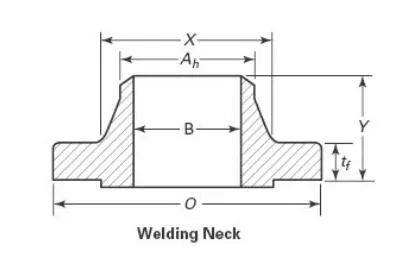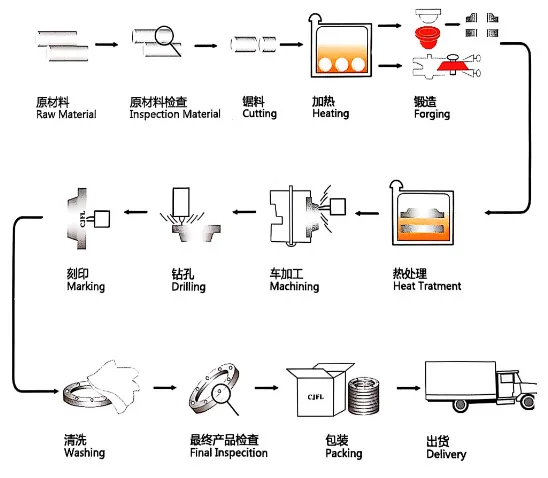
Titanium Weld Neck Flanges (WNRF) are high-integrity pipe flanges designed for butt-welding to piping systems. Their long tapered neck provides smooth stress distribution between flange and pipe, making them ideal for high pressure, high temperature, or cyclic loading applications. Manufactured according to ASTM B381, titanium weld neck flanges offer outstanding corrosion resistance and are especially suited for aggressive or seawater environments.

They are commonly used in chemical plants, desalination, offshore platforms, and nuclear or power generation systems.
|
Material Grade |
Gr1, Gr2, Gr3, Gr4, GR5, Gr7, Gr9, Gr11 |
|
Standard |
ANSI B16.5, ASTM B16.5, ASME B16.47, JIS B2220, DIN2627-2628, AWWA, ASTM A182 AND ASME SA182, GOST 12820 / 12821-80, etc. |
|
Size |
1/2"-60"NB NPS 1/2-NPS 24 (DN 10 - 2000) |
|
Pressure Class |
PN2.5, PN6, PN10, PN16, PN25, PN40, PN63, PN100, PN160, PN250, PN320, PN400 150#, 250#, 300#, 400#, 500#, 600#, 900#, 1500#, 2500# |
|
Flange Face Types / Connection Type |
Flat Face Flange (FF), Raised Face Flange (RF), Ring Joint Flange (RTJ) |
|
Product specifications can be customized according to customer drawing. |
|

Titanium weld neck flanges are widely used in demanding industrial sectors due to their outstanding corrosion resistance, high strength-to-weight ratio, and excellent weldability:
Titanium WN
Flanges for Chemical and Petrochemical Industry
Used in systems that transport corrosive media such as strong acids,
alkalis, and solvents.
Titanium WN
Flanges for Marine Engineering and Seawater Desalination
Ideal for heat exchangers, evaporators, and condenser pipelines that are
exposed to chloride-rich environments.
Titanium WN
Flanges for Aerospace Industry
Applied in engine components and high-temperature gas systems, where
strength, lightweight, and pressure resistance are essential.
Titanium WN Flanges for Pharmaceutical and Food Industry
Utilized in sterile pipeline systems and bioreactors, where material purity and stability are critical.
Titanium WN
Flanges for Power and Nuclear Sector
Deployed in nuclear reactor cooling systems and high-temperature, high-pressure
water-steam pipelines with excellent radiation resistance.
|
Visual Inspection |
To check for surface defects such as cracks, dents, scratches, and deformations. |
|
Dimensional Inspection |
Verify outer diameter, thickness, bolt circle diameter, sealing surface dimensions, etc. |
|
Chemical Composition Analysis |
Performed by spectrometer or ICP to ensure the titanium grade (e.g., Gr.2, Gr.5) complies with standards. |
|
Mechanical Properties Testing |
Includes tensile strength, yield strength, elongation, etc., according to ASTM B381 or relevant standards. |
|
Non-Destructive Testing (NDT) |
Typically includes Ultrasonic Testing (UT) or Dye Penetrant Testing (PT) to detect internal or surface flaws. |
|
Pressure Testing (Hydrostatic Test) |
For pressure applications, hydrostatic testing may be conducted to verify strength and sealing performance. |
|
Sealing Surface Flatness Check |
Checks the smoothness and flatness of the sealing face (e.g., RF, FF) to ensure tight sealing. |
|
Hardness Testing |
Brinell or Vickers hardness testing to assess material condition or heat treatment if required. |
Tests are based on standards such as ASTM B381, ASME B16.5, GB/T 9119, EN 1092-1, etc.
Third-party inspection reports (SGS, TUV, BV) can be provided upon request.
For exports, common quality documents
include:
✔ Dimension Inspection Report
✔ Material Test Certificate (MTC)
✔ NDT Report
✔ Packing Inspection
Packing:
Packed in strong seaworthy plywood cases with proper labeling. Each flange is individually protected with plastic wrap or foam.Customized packaging and pallet available upon request.
Flange Type and its code

Flange Sealing Surface Type and its code
